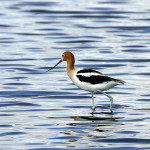• • •
American Avocets have an elegant posture, with a needle of a bill that turns up at the end. Their head and neck are generally pale but turn a rich cinnamon during breeding season. In profile and gait, they resemble the Black-necked Stilt, but Avocets have broad black and white stripes on their backs and light gray legs, while the Stilt is black on top, with red legs.
• Length: 18 inches
• Wingspan: 31 inches
• Season: Migrating March-May and July-October
More about American Avocets.
Where they are, and when.
Avocets gather in shallow prairie ponds, coastal mudflats and fresh and saltwater marshes. They feed in flocks by sweeping their bill through the mud or water to stir up crustaceans, fish and insects.
In an elaborate courtship ritual, they preen, dip their bills and stride together in the water. Their nests, which hold three or four pale eggs with black and brown blotches, are little more than piles of grass on the ground. If water rises around the nest they’ll fortify it with more grass and sticks. Avocets often defend their nests vigorously with loud cries, a “broken-wing” act and diving attacks on predators.
Their downy chicks are highly independent and may leave the nest within hours of hatching to forage and swim and are able to fly after four to six weeks.
Some Avocets reside on the Gulf Coast year-round, but their numbers increase in the spring and fall when many migrate to and from their winter home in Mexico and Central America.
March 24, 2012
A small flock of American Avocets strolled in the shallows and mudflats of the Boliver Flats Bird Sancutary. They weren’t feeding or courting, just milling about, pairing up for conversation in different groups like aristocrats at an exclusive party. Having ruffled another flock earlier trying to get too close, I hung back as they slowly worked their way down the peninsula. Unfortunately, a coyote appeared suddenly on the beach behind me, walking erratically with its head at an odd angle, forcing me to make a hasty retreat to the car.
• • •
June 9, 2012
Most of the time I’ve run across Avocets, they were in groups of a dozen or more, but these two were alone on Gator Nest Pond in Brazoria National Wildlife Refuge, sweeping the water looking for a meal. They walked fairly far into the pond – deeper than you see most wading birds go – before circling back to the clumps of tall grass nearer the bank.





